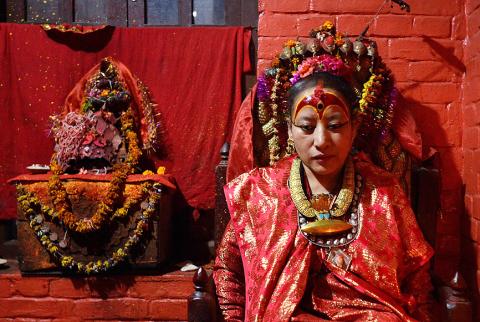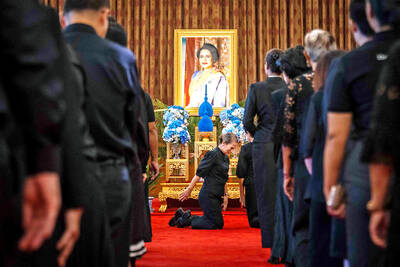When a massive earthquake struck Nepal in April, Nepal’s longest-serving “living goddess” was forced to do the unthinkable — walk the streets for the first time in her life, she told reporters in a rare interview.
Still following the cloistered lifestyle she entered at the age of two, Dhana Kumari Bajracharya also opened up about her unusually long 30-year reign, suggesting the pain of her unceremonious dethroning in the 1980s was still raw. Before the magnitude 7.8 earthquake on April 25, Bajracharya had only ever appeared in public while being carried in an ornate wooden palanquin. The Himalayan nation’s living goddesses, known as Kumaris, live in seclusion and rarely speak in public, bound by customs that combine elements of Hinduism and Buddhism.
However, as the tremor hit, shaking the ground, reducing buildings to rubble and killing thousands, Bajracharya left her quarters in the historic city of Patan, south of Kathmandu, for the first time in three decades. And for the first time on foot.

Photo: AFP
“I had never thought about leaving the house like that,” she said, clearly still traumatized by the disaster that claimed more than 8,800 lives.
“Perhaps the gods are angry, because people don’t respect traditions as much anymore,” Bajracharya, 63, added.
As the disaster ripped through Nepal, shaking Bajracharya’s five-story home, her family stayed indoors, waiting to see if the retired Kumari would break tradition and walk out with them.
“We couldn’t just leave the house like everyone else, we had to think of her. We didn’t know what to do, but when nature forces you, you do the unthinkable,” her niece Chanira said.
Bajracharya was enthroned in 1954 when she was just two years old and reigned for three decades as the Kumari of Patan.
The Kumari, a prepubescent girl from the Newar community, is considered an embodiment of the Hindu goddess Taleju.
Selection criteria are strict and include a number of specific physical attributes, from an unblemished body to a chest like a lion and thighs like a deer.
Unlike Kathmandu’s “living goddess” who must move to an official residence, the Patan Kumari is allowed to live with her family, but can only emerge on feast days when she is paraded through the city to be worshipped.
“I loved going out during the festivals the most,” Bajracharya said, remembering how devotees lined up along Patan’s narrow streets, eager to receive her blessings.
The Patan Kumari is traditionally dethroned once she begins to menstruate and, since Bajracharya never started her periods, she continued to serve well into her thirties.
However, in 1984, then-Nepalese crown prince Dipendra, who would go on to massacre his family 17 years later, stirred up a controversy that eventually ended her tenure.
“Why is she so old?” the 13-year-old prince reportedly asked when he saw Bajracharya during a festival, prompting priests to replace her with a young girl. Thirty years later, the memory of her abrupt dismissal still stings.
“They had no reason to replace me,” she told reporters. “I was a little angry. I felt the goddess still resided in me.”
Forced into retirement, Bajracharya decided to continue living the life she had always known, unable to abandon her duties or end her withdrawal from the outside world.
Every morning she wakes up, drapes an embroidered red skirt like the one she wore during her years as a Kumari, scrapes her hair into a topknot and lines her eyes with kohl curving upwards to her temples.
On special occasions, she uses red and yellow powder to draw a third eye in the middle of her forehead and takes to a wooden throne decorated with brass snake carvings.
Devotees are received, as when she was an official Kumari, on Saturdays and during festivals in a separate room in her red brick home reached by narrow stairs above two floors rented out to a shop and financial cooperative.
“The priests did what they had to do, but I cannot abandon my responsibilities,” she said.
When Bajracharya’s niece Chanira was chosen as a Kumari in 2001, she guided her through the process.
While Nepal has seen sweeping changes during Bajracharya’s lifetime, transforming from a Hindu kingdom to a secular republic, the routine of the former “living goddess” remains the same.
Her one concession to modernity is a fondness for TV, especially current affairs shows and Indian mythological dramas.
However, since the earthquake she spends most of her time engrossed in prayer, according to Chanira.
“It saddened her immensely... Our astrologer had predicted last year that my aunt would leave the house, and we were wondering how that would ever happen, but we never expected this,” she said.

DOUBLE-MURDER CASE: The officer told the dispatcher he would check the locations of the callers, but instead headed to a pizzeria, remaining there for about an hour A New Jersey officer has been charged with misconduct after prosecutors said he did not quickly respond to and properly investigate reports of a shooting that turned out to be a double murder, instead allegedly stopping at an ATM and pizzeria. Franklin Township Police Sergeant Kevin Bollaro was the on-duty officer on the evening of Aug. 1, when police received 911 calls reporting gunshots and screaming in Pittstown, about 96km from Manhattan in central New Jersey, Hunterdon County Prosecutor Renee Robeson’s office said. However, rather than responding immediately, prosecutors said GPS data and surveillance video showed Bollaro drove about 3km

Tens of thousands of people on Saturday took to the streets of Spain’s eastern city of Valencia to mark the first anniversary of floods that killed 229 people and to denounce the handling of the disaster. Demonstrators, many carrying photos of the victims, called on regional government head Carlos Mazon to resign over what they said was the slow response to one of Europe’s deadliest natural disasters in decades. “People are still really angry,” said Rosa Cerros, a 42-year-old government worker who took part with her husband and two young daughters. “Why weren’t people evacuated? Its incomprehensible,” she said. Mazon’s

‘MOTHER’ OF THAILAND: In her glamorous heyday in the 1960s, former Thai queen Sirikit mingled with US presidents and superstars such as Elvis Presley The year-long funeral ceremony of former Thai queen Sirikit started yesterday, with grieving royalists set to salute the procession bringing her body to lie in state at Bangkok’s Grand Palace. Members of the royal family are venerated in Thailand, treated by many as semi-divine figures, and lavished with glowing media coverage and gold-adorned portraits hanging in public spaces and private homes nationwide. Sirikit, the mother of Thai King Vajiralongkorn and widow of the nation’s longest-reigning monarch, died late on Friday at the age of 93. Black-and-white tributes to the royal matriarch are being beamed onto towering digital advertizing billboards, on

POWER ABUSE WORRY: Some people warned that the broad language of the treaty could lead to overreach by authorities and enable the repression of government critics Countries signed their first UN treaty targeting cybercrime in Hanoi yesterday, despite opposition from an unlikely band of tech companies and rights groups warning of expanded state surveillance. The new global legal framework aims to bolster international cooperation to fight digital crimes, from child pornography to transnational cyberscams and money laundering. More than 60 countries signed the declaration, which means it would go into force once ratified by those states. UN Secretary-General Antonio Guterres described the signing as an “important milestone,” and that it was “only the beginning.” “Every day, sophisticated scams destroy families, steal migrants and drain billions of dollars from our economy...